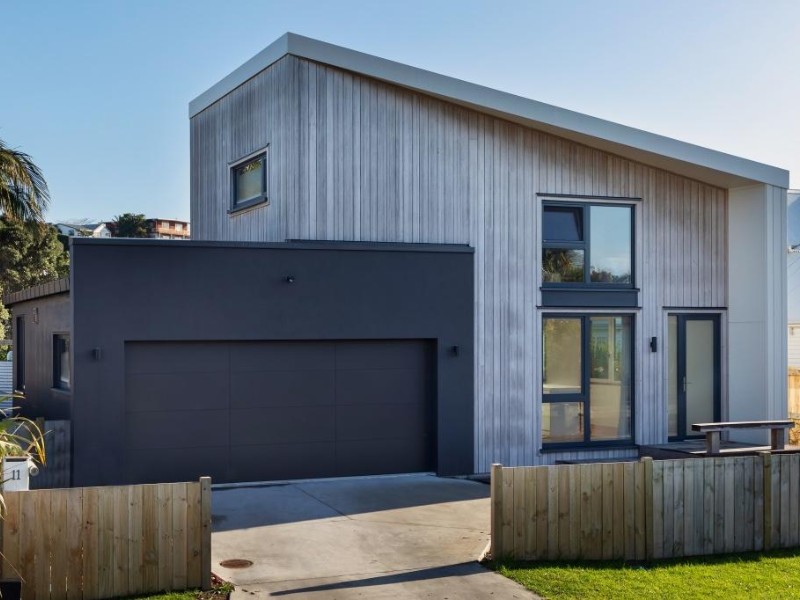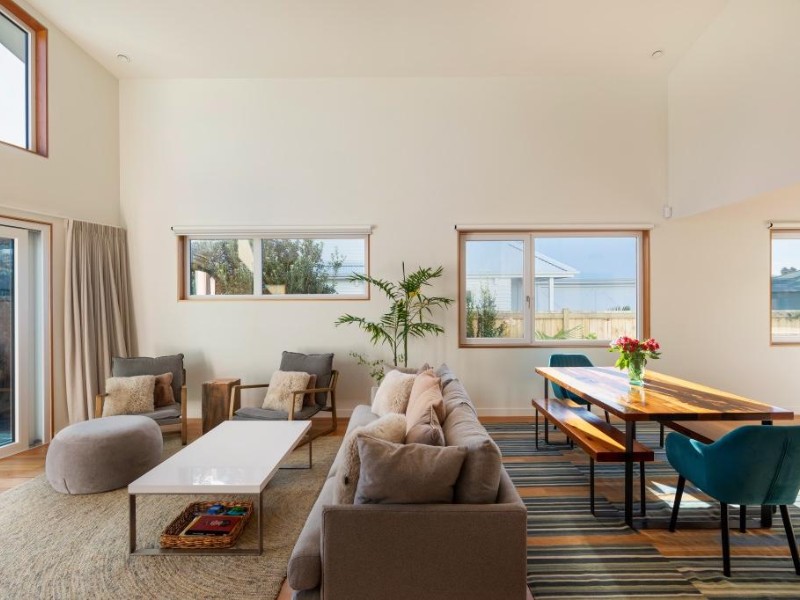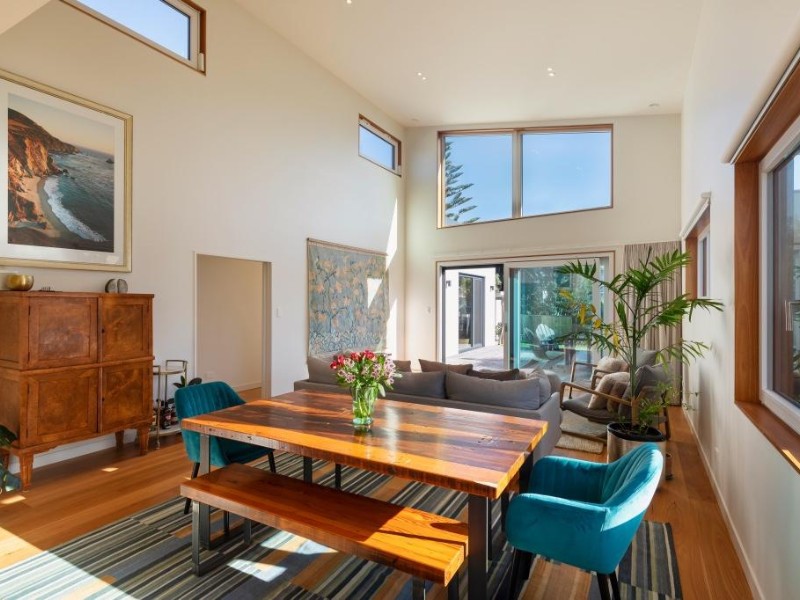When Mark Ashforth and his wife Megan Nielsen moved back to Aotearoa from America five years ago they wanted to build a family home which nurtured its occupants and the environment.
Fueled by Mark’s conservation studies at the University of California, their observations of greener ways of living and the sustainable renovation of a Victorian villa in Berkeley, the couple has built a contemporary home with low energy consumption and a reduced environmental footprint.
Recently awarded a 9 Homestar rating, the couple’s home showcases their care for the planet and best practice performance.
Essentials
Owner: Mark Ashforth and Megan Nielsen
Location: Walton Street, Red Beach, Hibiscus Coast, Auckland
What: domestic dwelling; 234 square metres; three bedrooms and an office
Where: 800 metres walk from Red Beach
Occupancy: three people
Project certification: 9 Homestar Built Rating (June 2022)
Project Snapshot
Architect: Construkt Architects
Main contractor: Craft Homes
Building enclosure specialist: Oculus Architectural Engineering Ltd
Homestar assessor: Enveloped
Project timeline: planning and design late 2018, existing dwelling on-site relocated December 2019, construction of new dwelling January to October 2020, occupancy October 2020

In the seaside suburb of Red Beach the highly contemporary Ashforth-Nielsen house sits in sharp contrast to its streetscape of largely 1970s housing.
During its construction phase neighbourhood curiosity grew as its modern angular form emerged on site.
Twenty years ago Mark had bought the Red Beach section with its small beach house as an investment property while briefly home from overseas.
Over the years the 89 square metre dwelling had been rented out but when Mark, Megan and their young son returned from the US to live here in 2017 they initially made it their home.
“We looked at expanding and updating the beach house but preliminary concept plans didn’t change it much without major work and expense. So we opted to sell and relocate it, and build new on the same site,” says Mark.
Making sure that new build would be environmentally-positive was a number one priority.
“Building a home was one of the biggest financial investments that we have ever made. It made sense to do it right – sustainable, highly efficient, low energy and low environmental impact - regardless of whether we plan to live here forever.”
Having worked in sustainable design and build technology in the States, Mark was familiar with the LEED green building rating system (administered by the US Green Building Council) – and Homestar seemed similar.
Homestar also aligned with the couple’s advocacy for better quality, better performing homes and buildings benefitting both occupants and the environment.

With Construkt Architects on board, a high-performance family home was mapped out with key objectives; year-round warmth and comfort, low energy consumption, and the use of low environmental impact materials.
Discussions with the wider project team identified a 9 Homestar rating as the target.
Construkt Architects’ directors Madushin Amarasekera and Glenn Kevey say a simple, uncomplicated form was needed to suit the orientation and modest budget.
“The design was primarily driven by optimising solar access and mitigating excessive solar gain over the summer months. Large windows allowed winter sun to flood in whilst a pergola controlled excess solar glare in summer,” says Madushin.
“The envelope design was managed through the technical process ensuring the required levels of insulation and airtightness were met. In short the simplicity of the form lent itself to passive outcomes.”
Glenn says one of the building’s most exciting features is its mechanical ventilation with heat recovery system providing clean, filtered, and tempered air through the house.
Oculus Architectural Engineering Ltd research and development manager, Jon Davies, assisted with blower door testing.
“The stand-out feature is the planned combination of mechanical ventilation with built-in heat recovery, insulation – including uPVC windows that keep the sound out and the heat in – and a dedicated airtightness layer to prevent draughts and heat loss. This has resulted in a very small heating requirement to maintain 20 degrees throughout the house,” he says.
After two years of living in their new home the couple says the house has met their expectations for comfort, well-being and sustainability.
“I think it is a combination of factors that enable the house to perform so well. Airtightness, insulation and ventilation and highly efficient joinery (German uPVC/aluminium thermally broken joinery). I also love that we collect our rainwater and have an efficient water heater,” says Mark.
“The house is so quiet with stable temperature and humidity. We rarely use the heat pump repurposed from the old beach house and our energy consumption is approximately 50 percent less than the old house.”
“Homestar has given us reassurance that we built a home above the New Zealand Building Code. Hopefully as Homestar rated homes gain more acknowledgement and understanding, architects, investors, and developers will learn and appreciate the benefits of living in a better performing home.”
“We’re proud and psyched to have received a 9 Homestar rating.”
Construkt Architects says that outstanding 9 star certification is a reflection of Mark and Megan’s “vision, courage and determination to build a 9 Homestar home.”

Despite that determination the design and build process was a new experience for the couple and not without its challenges.
Beginning construction at the start of the pandemic, time constraints, communicating with the bank via a broker and difficulties with customer service for products supplied from Europe were all part of the mix.
“Our advice to those embarking on a Homestar project would be read up on it. Look for an architect and builder with Homestar experience from the outset. There needs to be great communication between your architect and the builder from the beginning.”
The couple say they have been surprised by aspects of the New Zealand construction industry.
When renovating their 1906 villa in Berkeley, California, local authority rules and regulations focused on fostering more efficient, better performing homes.
“Any renovations above a certain value mandated efficiency upgrades, some of which are included in Homestar. The Berkeley City Council also required additional sustainable approaches during construction as part of the permits. I was
a little bit shocked that New Zealand was still so far behind in this space,” says Mark.
Likewise, they have been struck that change and new ways of doing and thinking about buildings can be very challenging for some people.
“There are industries in New Zealand that are very invested in not changing,” says Megan.
Main contractor Craft Homes says a house built to the current New Zealand building code is “very poor compared to international standards” and “Homestar provides much higher performance targets to work towards, meaning your home will be much more energy efficient, healthy and comfortable as well as future-proofed.”
With greater education about sustainability amongst trades, suppliers and end-users, Mark and Megan see Homestar as a pathway for better residential housing in Aotearoa.
“Ideally the government would join in and mandate some of the low hanging fruit to speed things up. A lot of developers and people building homes are short term focused – the government should be looking further ahead, provide pathways and financial incentives to improve buildings,” says Mark.
For now the Ashforth-Nielsen family is enjoying the thermal comfort of their home, its consistent metrics (Watercare, Octopus Energy for notifications, Govee and SensorPush sensors for temperature and humidity) and the growing garden outside including totara, avocado and coastal native shrubs.
“The house is warm, beautiful and light and it feels calm, earthy, grounding and just so peaceful and quiet when you walk in,” says Megan.
